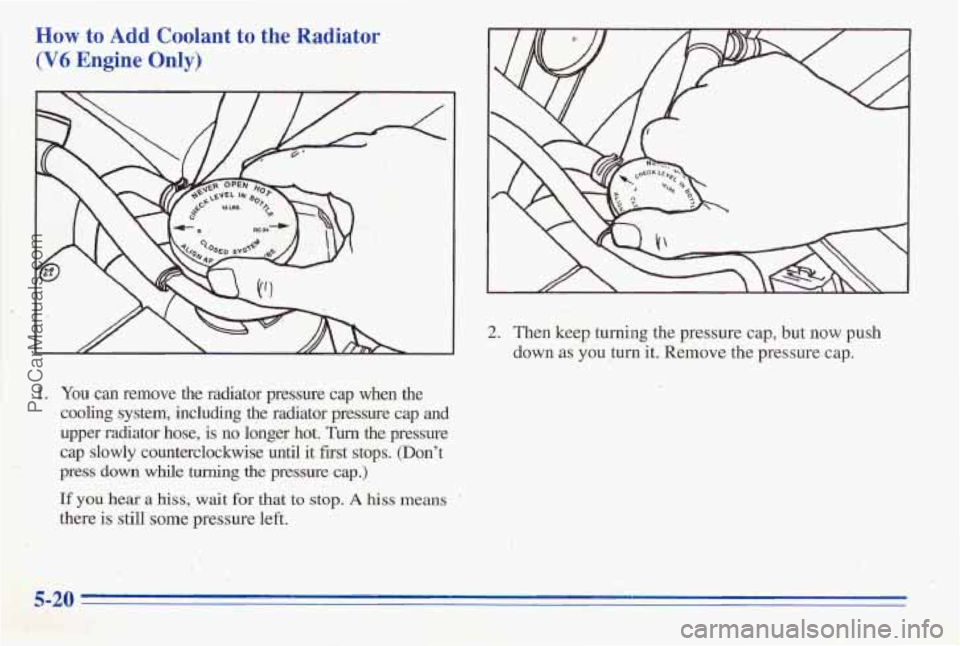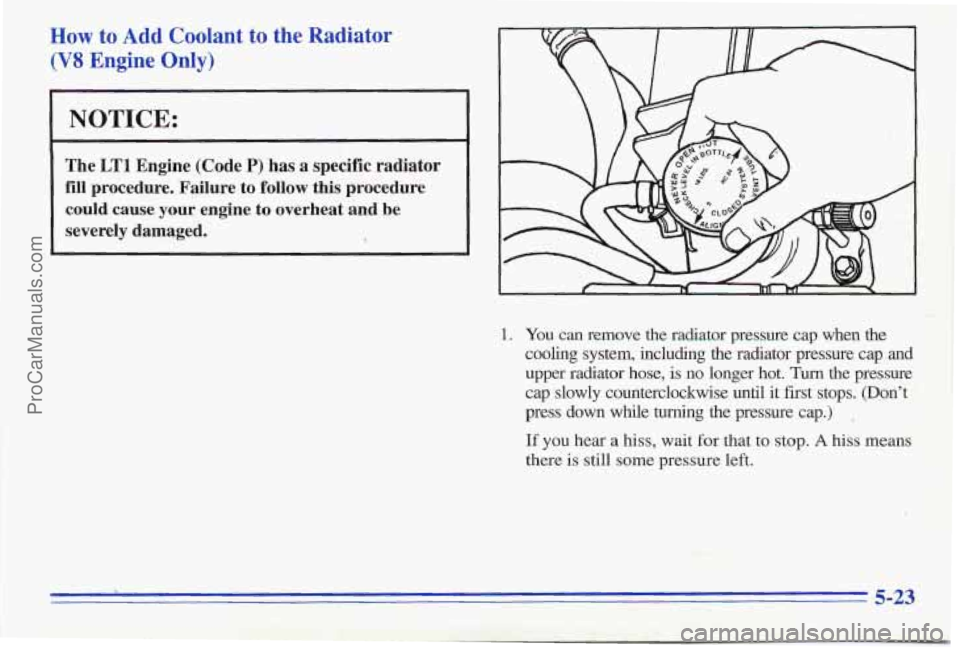engine PONTIAC FIREBIRD 1996 Repair Manual
[x] Cancel search | Manufacturer: PONTIAC, Model Year: 1996, Model line: FIREBIRD, Model: PONTIAC FIREBIRD 1996Pages: 386, PDF Size: 19.18 MB
Page 216 of 386

Heater and radiator hoses, and other engine
parts, can be very hot. Don’t touch them.
If you
do, you can be burned.
Don’t run the engine if there is a leak.
If you run
the engine, it could lose all coolant. That could
cause
an engine fire, and you could be burned.
Get any leak fixed before you drive the vehicle.
NOTICE:
Engine damage from running your engine
without coolant isn’t covered by your warranty.
If there seems to be no leak, with the engine on, check to
see if the electric engine fan is running. If the engine
is
overheating, the fan should be running. If it isn’t, your
vehicle needs service.
How to Add Coolant to the Coolant
Recovery Tank
If you haven’t found a problem yet, but the coolant level
isn’t at
FULL COLD, add a 50/50 mixture of clean
water
(preferably distilled) and DEX-COOL TM
(orange-colored, silicate-free) antifreeze at the coolant
recovery tank. (See “Engine Coolant” in the Index for
more information.)
I A CAUTION:
Adding only plain water to your cooling system
can be dangerous. Plain water, or some other
liquid like alcohol, can boil before the proper
coolant mix
will. Your vehicle’s coolant warning
system is set for the proper coolant mix. With
plain water or the wrong mix, your engine could
get too hot but you wouldn’t get the overheat
warning. Your engine could catch fire and you or
others could be burned. Use a
50/50 mix of clean
water and
DEX-COOL TM antifreeze.
ProCarManuals.com
Page 217 of 386

NOTICE:
.In cold weather, water can freeze and crack the
engine, radiator, heater core
and other parts.
Use the recommended coolant and the proper
coolant
mix.
- -
You can be burned if you spill coolant on hot
engine parts. Coolant contains ethylene glycol
and it will burn
if the engine parts are hot
enough. Don't
spill coolant on a hot engine.
When the coolant in the coolant recovery tank is at
FULL COLD, start your vehicle.
If the overheat warning continues, there's one more
thing you can try. You can add the proper coolant mix
directly to the radiator, but be sure the cooling system is
cool before you do it.
5-18
ProCarManuals.com
Page 219 of 386

HOW to Add Coolant to the Radiator
i'l (V6 Engine Only)
2. Then keep turning the pressure cap, but now push
down
as you turn it. Remove the pressure cap.
1. You can remove the rachator pressure cap when the
cooling system, including ,&e radiator pressure cap Bnd
upper radiator hose,
is no longer hot. Turn the pressure
cap slowly counterclockwise until
it first stops. (Don't
press down while turning the pressure cap.)
If you hear a hiss, wait for that to stop. A hiss means '
there is still some pressure left.
5-20
ProCarManuals.com
Page 221 of 386

6. Start the engine and let it run until you can feel the
upper radiator hose getting hot. Watch out for the
engine
fan.
filler neck may be lower. If the level is lower, add
more
of the proper mix through the filler neck until
the level reaches the base
of the filler neck.
7. By this time the coolant level inside the radiator
8. Then replace the pressure cap. At any time during
this procedure if coolant begins to flow out
of the
filler neck, reinstall the pressure cap. Be sure the
arrows on the pressure cap line up like this.
, 'I I
5-22
ProCarManuals.com
Page 222 of 386

How to Add Coolant to the Radiator
(V8 Engine Only)
NOTICE:
The LTl Engine (Code P) has a specific radiator
fill procedure. Failure to follow this procedure
could cause your engine to overheat and be
severely damaged.
<
I
1. You can remove the radiator pressure cap when the
cooling system, including the radiator pressure cap and upper radiator hose, is
no longer hot. Turn the pressure
cap slowly counterclockwise until it first stops. (Don’t
press down while turning the pressure cap.)
.
If you hear a hiss, wait for that to stop. A hiss means
there is still some pressure left.
ProCarManuals.com
Page 223 of 386

2. Then keep turning the pressure cap, but now gush
down as you turn it, Remove the pressure cap.
/rl CAUTION:
I
1
You can be burned if you spill coolant on hot
engine parts. Coolant contains ethylene glycol,
and it
will burn if the engine parts are hot
enough Don't spill coolant
on a hot engine.
3. After the engine cools, open the air bleed valves on
the heater return hose and water pump inlet.
ProCarManuals.com
Page 224 of 386

4. Fill with the proper mix. Add coolant until you
see a steady stream of coolant coming from the
bleed valves.
.. i L . -8
-.
5. Close the bleed valves.
6. Continue to fill the radiator up to the base of the
7. Rinse or wipe the spilled coolant from the engine
and compartment.
8. Start the engine and allow it to run in idle for
approximately four minutes. By this time, the
coolant level inside the radiator will be lower.
Add
more of the proper mix through the filler neck until
the level reaches the base of the filler neck.
filler
neck.
I. . :-
ProCarManuals.com
Page 225 of 386

9. Shut the engine off and replace the pressure cap. Be
sure the arrows on the cap line up like this.
10. Then fill the coolant recovery tank to the proper
level.
For a complete
drain, flush and refill, see your Pontiac
dealer or a Pontiac Firebird Service Manual. To
purchase a service manual, see “Service and Owner
Publications”
in the Index.
5-26
ProCarManuals.com
Page 226 of 386

If a Tire Goes Flat
It’s unusual for a tire to “blow out” while you’re driving,
especially
if you maintain your tires properly. If air goes
out of a tire, it’s much more likely to leak out slowly.
But if you should ever have a “blowout,” here are a few
tips about what to expect and what to do:
If a front tire fails, the flat tire will create a drag that
pulls the vehicle toward that side. Take your foot
off the
accelerator pedal and grip the steering wheel
firmly.
Steer to maintain lane position, and then gently bralie to
a stop well out
of the traffic lane.
A rear blowout, particularly on a curve, acts much like a
skid and may
require the same correction you’d use in a
skid. In any rear blowout, remove your foot from the
accelerator pedal. Get the vehicle under control by
steering the way you want the vehicle to
go. It may be
very bumpy and noisy, but you can still steer. Gently
brake to a stop
-- well off the road if possible.,
If a tire goes flat, the next part shows how to use your
jacking equipment to change a flat tire safely.
Changing a Flat Tire
If a tire goes flat, avoid further tire and wheel damage
by driving slowly
to a level place. Turn on your hazard
warning flashers.
I
A CAUTILN:
Changing a tire can cause an injury. The vehicle
can slip off the jack and roll over
you or other
people. You and they could be
badly injured.
Find
a level place to change your tire. To help
prevent the vehicle from moving:
1. Set the parking brake firmly.
2. Put an automatic transmission shift
lever in
PARK (P), or shift a manual
transmission to
FIRST (1) or
REVERSE (a).
3. Turn off the engine.
To be even more certain the vehicle won’t move,
you can put blocks
at the front and rear of the
tire farthest away from the one being changed.
That would be the tire on the other side of the
vehicle,
at the opposite end.
5-27
ProCarManuals.com
Page 239 of 386

Compact Spare Tire
Although the compact spare tire was fully inflated when
your
vehicle was new, it can lose air after a time. Check
the inflation pressure regularly. It should be 60 psi
(420 Wa).
After installing the compact spare on your vehicle, you
should stop as soon as possible and make sure your
spare tire is correctly inflated. The compact spare is
made
to perform well at posted speed limits for
distances up to 3,000 miles (5 000 km), so you can
finish your trip and have your full-size tire repaired or
replaced where you want. Of course, it’s best to replace
your spare with a full-size tire as soon as you can. Your
spare will last longer and be in good shape in case
you
need it again. When
the compact spare is
on the rear axle, the optional
traction control system will cycle and limit acceleration
for about the first
15 seconds of driving after each
engine start.
I NOTICE:
When the compact spare is installed, don’t take
your vehicle through
an automatic car wash with
guide rails. The compact spare can get caught on
the rails. That can damage the tire and wheel,
and maybe other parts
of your vehicle.
5-40
ProCarManuals.com